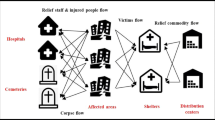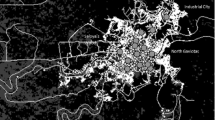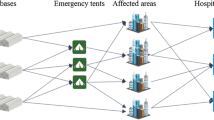Abstract
Cascade disasters can destroy urban infrastructures, kill thousands of people, and permanently displace millions of people. The paramount goal of disaster relief programs is to save lives, reduce financial loss, and accelerate the relief process. This study proposes a bi-level two-echelon mathematical model to minimize pre-disaster costs and maximize post-disaster relief coverage area. The model uses a geographic information system (GIS) to classify the disaster area and determine the optimal number and location of distribution centers while minimizing the relief supplies’ inventory costs. A simulation model is used to estimate the demand for relief supplies. Initially, vulnerable urban infrastructures are identified, and then the interaction among them is investigated for cascade disasters. The aims of this study are threefold: (1) to identify vulnerable urban infrastructures in cascade disasters, (2) to prioritize urban areas based on the severity of cascade disasters using a GIS, and (3) to develop a bi-objective multi-echelon multi-supplies mathematical model for location, allocation, and distribution of relief supplies under uncertainty. The model is solved with an epsilon-constraint method for small and medium-scale problems and the invasive weed optimization algorithm for large-scale problems. A case study is presented to demonstrate the applicability and efficacy of the proposed method. The results confirm the difficulty of relief operations during the night as the cost of night-time relief operations is higher than daytime. In addition, the results show the coverage area increases as the demand surges. Therefore, establishing more distribution centers will increase operating costs and expand coverage are.

















Similar content being viewed by others
References
Abhijeet, D., Eun, H., & Makarand, H. (2011). Impact of flood damaged critical infrastructure on communities and industries. Built Environment Project and Asset Management, 1(2), 156–175.
Akbari, F., Valizadeh, J., & Hafezalkotob, A. (2021). Robust cooperative planning of relief logistics operations under demand uncertainty: A case study on a possible earthquake in Tehran. International Journal of Systems Science: Operations and Logistics, 1–24.
Arslan, O., Kumcu, G. Ç., Kara, B. Y., & Laporte, G. (2021). The location and location-routing problem for the refugee camp network design. Transportation Research Part B: Methodological, 143, 201–220.
Baharmand, H., Comes, T., & Lauras, M. (2019). Bi-objective multi-layer location–allocation model for the immediate aftermath of sudden-onset disasters. Transportation Research Part E: Logistics and Transportation Review, 127, 86–110.
Baloye, D. O., & Palamuleni, L. G. (2017). Urban critical infrastructure interdependencies in emergency management. Disaster Prevention and Management: An International Journal.
Barzinpour, F., & Esmaeili, V. (2014). A multi-objective relief chain location distribution model for urban disaster management. The International Journal of Advanced Manufacturing Technology, 70(5–8), 1291–1302.
Baser, B., & Behnam, B. (2020). An emergency response plan for cascading post-earthquake fires in fuel storage facilities. Journal of Loss Prevention in the Process Industries, 104155.
Berariu, R., Fikar, C., Gronalt, M., & Hirsch, P. (2015). Understanding the impact of cascade effects of natural disasters on disaster relief operations. International Journal of Disaster Risk Reduction, 12, 350–356.
Cao, C., Li, C., Yang, Q., Liu, Y., & Qu, T. (2018). A novel multi-objective programming model of relief distribution for sustainable disaster supply chain in large-scale natural disasters. Journal of Cleaner Production, 174, 1422–1435.
Caunhye, A. M., Li, M., & Nie, X. (2015). A location-allocation model for casualty response planning during catastrophic radiological incidents. Socio-Economic Planning Sciences, 50, 32–44.
Charnes, A., & Cooper, W. W. (1959). Chance-constrained programming. Management Science, 6(1), 73–79.
Doan, X. V., & Shaw, D. (2019). Resource allocation when planning for simultaneous disasters. European Journal of Operational Research, 274(2), 687–709.
Doodman, M., Shokr, I., Bozorgi-Amiri, A., & Jolai, F. (2019). Pre-positioning and dynamic operations planning in pre-and post-disaster phases with lateral transhipment under uncertainty and disruption. Journal of Industrial Engineering International, 1–16.
Du, B., Zhou, H., & Leus, R. (2020). A two-stage robust model for a reliable p-center facility location problem. Applied Mathematical Modelling, 77, 99–114.
Elçi, Ö., & Noyan, N. (2018). A chance-constrained two-stage stochastic programming model for humanitarian relief network design. Transportation Research Part B: Methodological, 108, 55–83.
Erbeyoğlu, G., & Bilge, Ü. (2020). A robust disaster preparedness model for effective and fair disaster response. European Journal of Operational Research, 280(2), 479–494.
Feng, Y., & Xiang-Yang, L. (2018). Improving emergency response to cascading disasters: Applying case-based reasoning towards urban critical infrastructure. International Journal of Disaster Risk Reduction, 30, 244–256.
Ghasemi, P., Khalili-Damghani, K., Hafezalkotob, A., & Raissi, S. (2019). Stochastic optimization model for distribution and evacuation planning (a case study of Tehran earthquake). Socio-Economic Planning Sciences, 100745.
Ghasemi, P., Khalili-Damghani, K., Hafezalkotob, A., & Raissi, S. (2019b). Uncertain multi-objective multi-commodity multi-period multi-vehicle location-allocation model for earthquake evacuation planning. Applied Mathematics and Computation, 350, 105–132.
Goda, K., Campbell, G., Hulme, L., Ismael, B., Ke, L., Marsh, R., & Koyama, M. (2016). The 2016 Kumamoto earthquakes: Cascading geological hazards and compounding risks. Frontiers in Built Environment, 2, 19.
Goli, A., Tirkolaee, E. B., Malmir, B., Bian, G. B., & Sangaiah, A. K. (2019). A multi-objective invasive weed optimization algorithm for robust aggregate production planning under uncertain seasonal demand. Computing, 101(6), 499–529.
Gong, Z., Wang, Y., Wei, G., Li, L., & Guo, W. (2020). Cascading disasters risk modeling based on linear uncertainty distributions. International Journal of Disaster Risk Reduction, 43, 101385.
Goodarzian, F., Abraham, A., & Fathollahi-Fard, A. M. (2021). A biobjective home health care logistics considering the working time and route balancing: A self-adaptive social engineering optimizer. Journal of Computational Design and Engineering, 8(1), 452–474.
Goodarzian, F., Hosseini-Nasab, H., Muñuzuri, J., & Fakhrzad, M. B. (2020). A multi-objective pharmaceutical supply chain network based on a robust fuzzy model: A comparison of meta-heuristics. Applied soft computing, 92, 106331.
Grassmann, W. K. (2014). Factors affecting warm-up periods in discrete event simulation. SIMULATION, 90(1), 11–23.
Haghi, M., Ghomi, S. M. T. F., & Jolai, F. (2017). Developing a robust multi-objective model for pre/post disaster times under uncertainty in demand and resource. Journal of Cleaner Production, 154, 188–202.
Hasani, A., & Mokhtari, H. (2018). Redesign strategies of a comprehensive robust relief network for disaster management. Socio-Economic Planning Sciences, 64, 92–102.
Hrdina, C. M., Coleman, C. N., Bogucki, S., Bader, J. L., Hayhurst, R. E., Forsha, J. D., & Knebel, A. R. (2009). The “RTR” medical response system for nuclear and radiological mass-casualty incidents: A functional TRiage-TReatment-TRansport medical response model. Prehospital and Disaster Medicine, 24(3), 167–178.
Khalili-Damghani, K., Abtahi, A. R., & Ghasemi, A. (2015). A new bi-objective location-routing problem for distribution of perishable products: Evolutionary computation approach. Journal of Mathematical Modelling and Algorithms in Operations Research, 14(3), 287–312.
Khojasteh, S. B., & Macit, I. (2017). A stochastic programming model for decision-making concerning medical supply location and allocation in disaster management. Disaster Medicine and Public Health Preparedness, 11(6), 747–755.
Komak Panah, A., & Hafezi Moghadas, N. (1993). Landslide hazard zonation study in affected area by manjil earthquake, 1990. TC4 (1993)-Manual for Zonation on Seismic Geotechnical Hazards.
Law, A. M. (2020). Statistical analysis of simulation output data: the practical state of the art. In: 2020 Winter Simulation Conference (WSC) (pp. 1117–1127). IEEE.
Maghfiroh, M. F., & Hanaoka, S. (2020). Multi-modal relief distribution model for disaster response operations. Progress in Disaster Science, 100095.
Maghsoudlou, H., Afshar-Nadjafi, B., & Niaki, S. T. A. (2016). A multi-objective invasive weeds optimization algorithm for solving multi-skill multi-mode resource constrained project scheduling problem. Computers and Chemical Engineering, 88, 157–169.
McCormak, T. C., Rad, F. N., & Eeri, M. (1997). An earthquake loss estimation methodology for building based on ATC-13 and ATC-21’. Earthquake Spectra, 13(4), 605–621.
Mehrabian, A. R., & Lucas, C. (2006). A novel numerical optimization algorithm inspired from weed colonization. Ecological Informatics, 1(4), 355–366.
Oh, E. H., Deshmukh, A., & Hastak, M. (2010). Disaster impact analysis based on inter‐relationship of critical infrastructure and associated industries. International Journal of Disaster Resilience in the Built Environment.
Ohnishi, T. (2012). The disaster at Japan’s Fukushima-Daiichi nuclear power plant after the March 11, 2011 earthquake and tsunami, and the resulting spread of radioisotope contamination. Radiation Research, 177(1), 1–14.
Pescaroli, G., & Alexander, D. (2015). A definition of cascading disasters and cascading effects: Going beyond the “toppling dominos” metaphor. Planet @ risk, 3(1), 58–67.
Rath, S., & Gutjahr, W. J. (2014). A math-heuristic for the warehouse location–routing problem in disaster relief. Computers and Operations Research, 42, 25–39.
Reza-Pour, F., & Khalili-Damghani, K. (2017). A new stochastic time-cost-quality trade-off project scheduling problem considering multiple-execution modes, preemption, and generalized precedence relations. Industrial Engineering and Management Systems, 16(3), 271–287.
Rooeinfar, R., Raissi, S., & Ghezavati, V. R. (2019). Stochastic flexible flow shop scheduling problem with limited buffers and fixed interval preventive maintenance: A hybrid approach of simulation and metaheuristic algorithms. SIMULATION, 95(6), 509–528.
Sarma, D., Das, A., & Bera, U. K. (2020). Uncertain demand estimation with optimization of time and cost using Facebook disaster map in emergency relief operation. Applied Soft Computing, 87, 105992.
Schroeder, A. J., Gourley, J. J., Hardy, J., Henderson, J. J., Parhi, P., Rahmani, V., & Taraldsen, M. J. (2016). The development of a flash flood severity index. Journal of Hydrology, 541, 523–532.
Shahabi, A., Raissi, S., Khalili-Damghani, K., & Rafei, M. (2019). Designing a resilient skip-stop schedule in rapid rail transit using a simulation-based optimization methodology. Operational Research, 1–31.
Tang, P., Xia, Q., & Wang, Y. (2019). Addressing cascading effects of earthquakes in urban areas from network perspective to improve disaster mitigation. International journal of disaster risk reduction, 35, 101065.
Tavana, M., Abtahi, A. R., Di Caprio, D., Hashemi, R., & Yousefi-Zenouz, R. (2018). An integrated location-inventory-routing humanitarian supply chain network with pre-and post-disaster management considerations. Socio-Economic Planning Sciences, 64, 21–37.
Velasquez, G. A., Mayorga, M. E., & Özaltın, O. Y. (2020). Pre-positioning disaster relief supplies using robust optimization. IISE Transactions, 1–19.
Yamashita, J., & Shigemura, J. (2013). The great east Japan earthquake, tsunami, and fukushima daiichi nuclear power plant accident: A triple disaster affecting the mental health of the country. Psychiatric Clinics, 36(3), 351–370.
Yang, M., Liu, Y., & Yang, G. (2021). Multi-period dynamic distributionally robust pre-positioning of emergency supplies under demand uncertainty. Applied Mathematical Modelling, 89, 1433–1458.
Yu, W. (2020). Reachability guarantee based model for pre-positioning of emergency facilities under uncertain disaster damages. International Journal of Disaster Risk Reduction, 42, 101335.
Zhan, S. L., Liu, S., Ignatius, J., Chen, D., & Chan, F. T. (2021). Disaster relief logistics under demand-supply incongruence environment: A sequential approach. Applied Mathematical Modelling, 89, 592–609.
Zhang, J., Wang, Z., & Ren, F. (2019). Optimization of humanitarian relief supply chain reliability: A case study of the Ya’an earthquake. Annals of Operations Research, 283(1), 1551–1572.
Zitzler, E. (1999). Evolutionary algorithms for multi-objective optimization: Methods and applications (Vol. 63). Ithaca: Shaker.
Zitzler, E., & Thiele, L. (1998). Multi-objective optimization using evolutionary algorithms—A comparative case study. In: International conference on parallel problem solving from nature (pp. 292–301). Springer, Berlin, Heidelberg.
Acknowledgements
Dr. Madjid Tavana is grateful for the partial support he received from the Czech Science Foundation (GAˇCR19-13946S) for this research.
Author information
Authors and Affiliations
Corresponding author
Ethics declarations
Conflict of interest
The above authors declare that they have no known competing financial interests or personal relationships that could have appeared to influence the work reported in this paper.
Additional information
Publisher's Note
Springer Nature remains neutral with regard to jurisdictional claims in published maps and institutional affiliations.
Rights and permissions
About this article
Cite this article
Khalili-Damghani, K., Tavana, M. & Ghasemi, P. A stochastic bi-objective simulation–optimization model for cascade disaster location-allocation-distribution problems. Ann Oper Res 309, 103–141 (2022). https://doi.org/10.1007/s10479-021-04191-0
Accepted:
Published:
Issue Date:
DOI: https://doi.org/10.1007/s10479-021-04191-0




